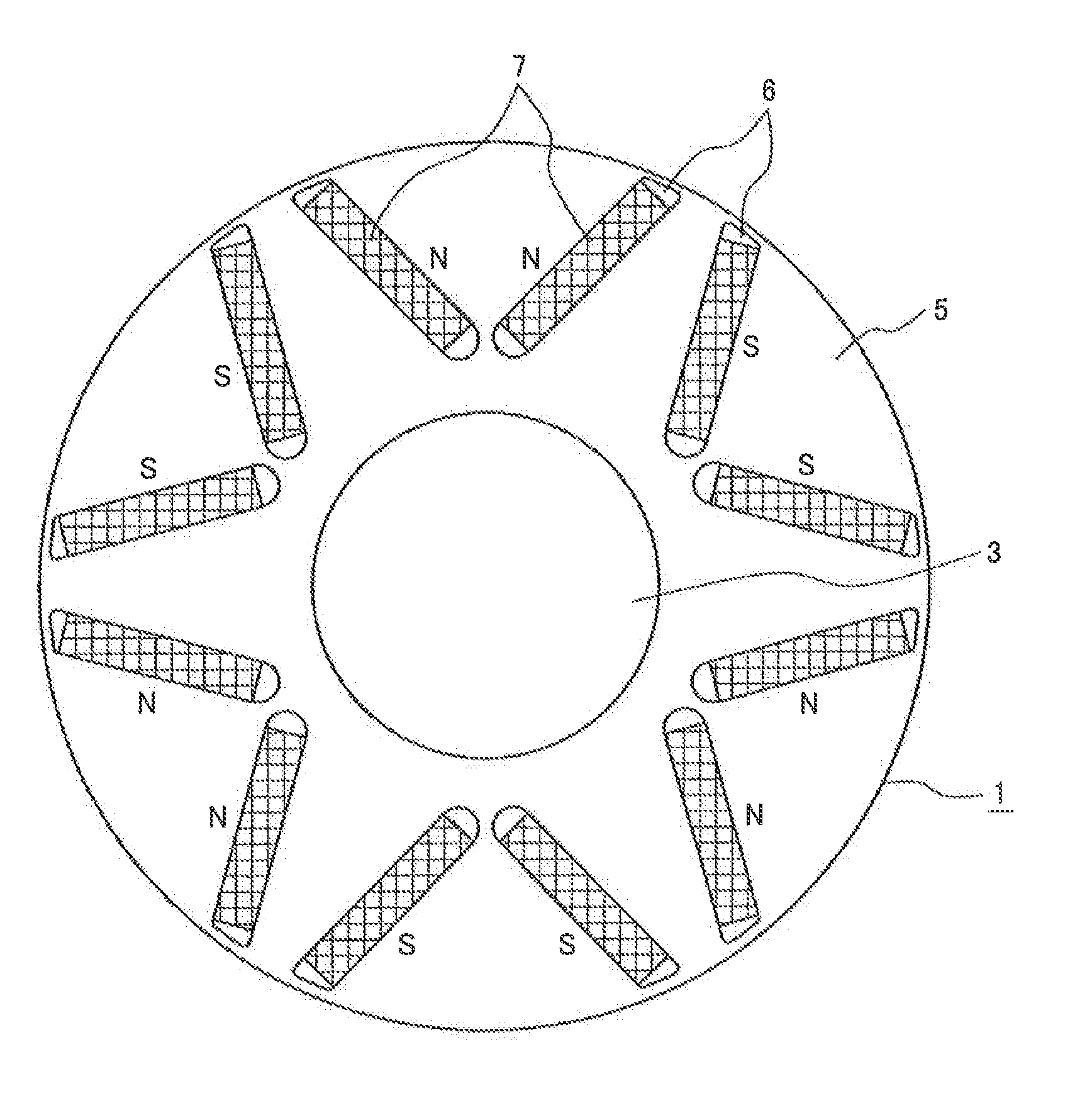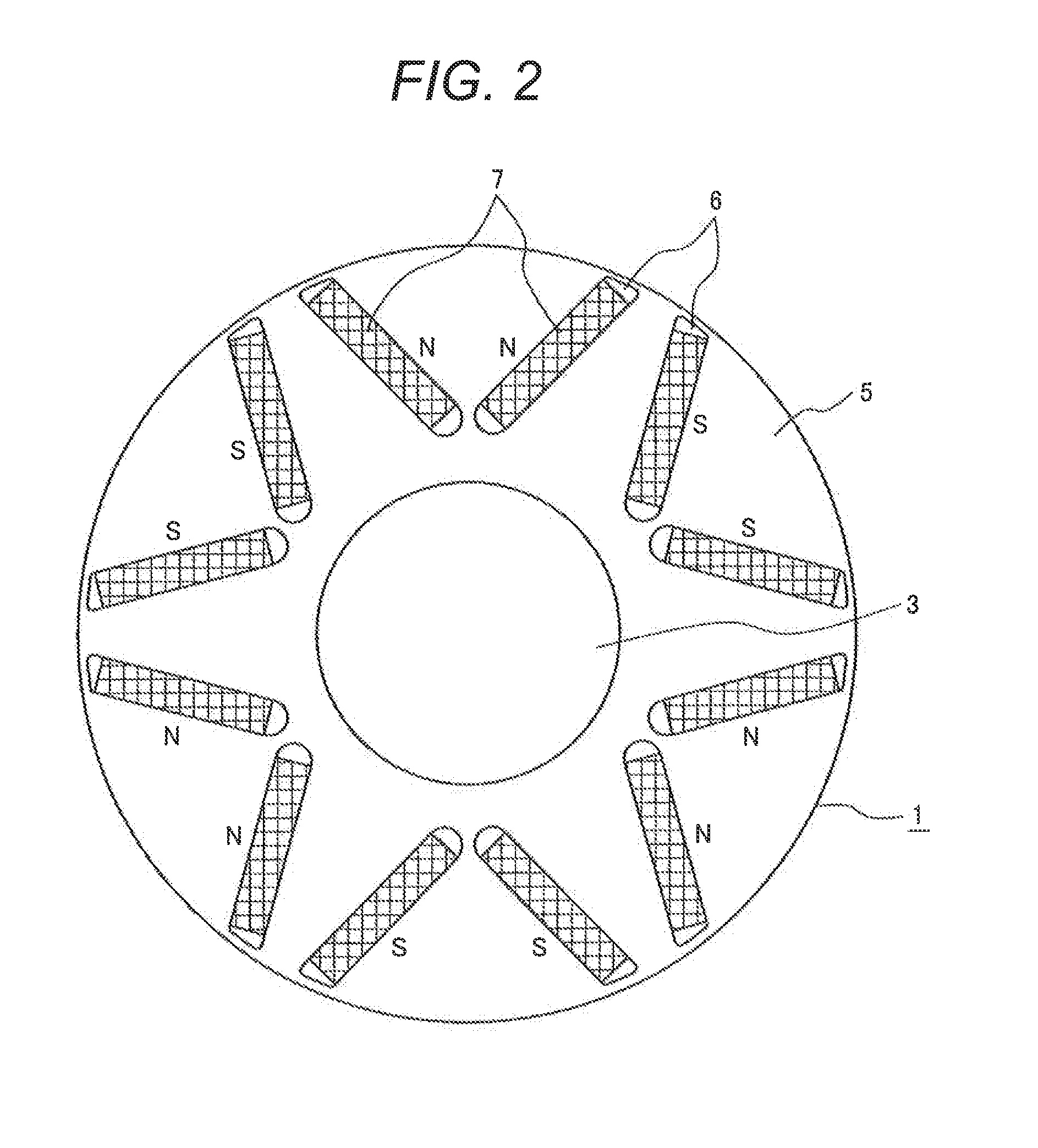Permanent Magnet Rotating Machine
a permanent magnet, rotating machine technology, applied in the direction of mechanical energy handling, magnetic circuit rotating parts, magnetic circuit shape/form/construction, etc., can solve problems such as electrical characteristics that may be worsened, and achieve the effects of reducing harmonic components, preventing magnetic flux concentration, and increasing efficiency
- Summary
- Abstract
- Description
- Claims
- Application Information
AI Technical Summary
Benefits of technology
Problems solved by technology
Method used
Image
Examples
first embodiment
[0043]FIG. 1 schematically shows the structure of a permanent magnet rotating machine with an output power of 1 to 3 MW that will be mounted in an electrical train as a railroad generator and will operate at a rotational speed of 500 min−1 to 2000 min−1.
[0044]As shown in the drawing, a rotor 1, in which permanent magnets are provided, is attached to a shaft 3, and a stator 2 is oppositely disposed with a predetermined distance left between the rotor 1 and stator 2. A coil 4 is embedded in the stator 2.
[0045]As shown in FIG. 2, the rotor 1 includes a rotor iron core 5, in which magnet insertion slots 6 are formed so that each two magnet insertion slots 6 with the same pole form a substantially V shape when viewed from the outer circumference of the rotor 1. Specifically, the two magnet insertion slots 6 formed in one pole are formed in a substantially V shape in which the circumferential distance therebetween becomes larger as the two magnet insertion slots extend toward the outer ci...
second embodiment
[0067]FIG. 11 shows the rotor of a six-pole permanent magnet rotating machine according to a second embodiment of the present invention. As shown in the drawing, the permanent magnet rotor includes a rotor iron core 16, in which magnet insertion slots 17 are formed so that two magnet insertion slots 17 form a substantially V shape for each pole when viewed from the outer circumference of the rotor, and a flat-plate magnet 7 is embedded in each magnet insertion slot 17.
[0068]FIG. 12 is an enlarged view of the magnet insertion slot 17. In this embodiment, to form a step, the width W of an end 8 of the magnet insertion slot 17 is smaller than the width Wg of a magnet insertion portion.
[0069]In this embodiment, a range in which the flat-plate magnet 7 moves in the width direction is narrowed by the step. Accordingly, when the rotor rotates, movement of the flat-plate magnet 7 in the magnet insertion slot 17 can be suppressed, preventing the magnet from being damaged due to vibration and...
third embodiment
[0075]In addition to the structures in the first and second embodiments, permanent magnets 22 disposed in a rotor iron core 21 are divided in the width direction as shown in FIG. 14, in this embodiment. This enables the eddy current generated in each permanent magnet 22 to be reduced, and thereby the efficiency can be improved and the temperature in the permanent magnet rotating machine can be reduced. Even if the permanent magnet 22 is divided in the axial direction, the same effect can be obtained.
PUM
 Login to View More
Login to View More Abstract
Description
Claims
Application Information
 Login to View More
Login to View More - R&D
- Intellectual Property
- Life Sciences
- Materials
- Tech Scout
- Unparalleled Data Quality
- Higher Quality Content
- 60% Fewer Hallucinations
Browse by: Latest US Patents, China's latest patents, Technical Efficacy Thesaurus, Application Domain, Technology Topic, Popular Technical Reports.
© 2025 PatSnap. All rights reserved.Legal|Privacy policy|Modern Slavery Act Transparency Statement|Sitemap|About US| Contact US: help@patsnap.com



